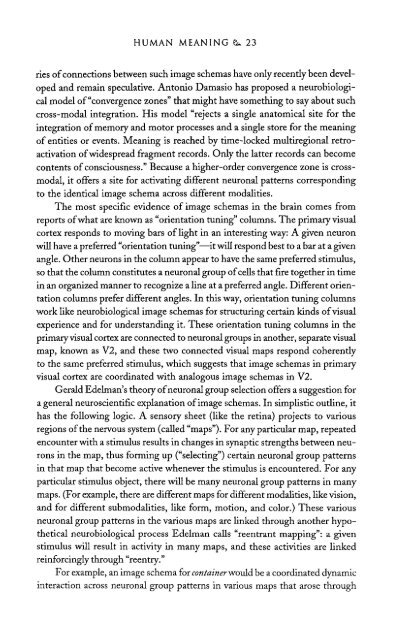The Literary Mind.pdf
The Literary Mind.pdf
The Literary Mind.pdf
Create successful ePaper yourself
Turn your PDF publications into a flip-book with our unique Google optimized e-Paper software.
HUMAN MEANING 23<br />
ries of connections between such image schemas have only recently been developed<br />
and remain speculative. Antonio Damasio has proposed a neurobiological<br />
model of "convergence zones" that might have something to say about such<br />
cross-modal integration. His model "rejects a single anatomical site for the<br />
integration of memory and motor processes and a single store for the meaning<br />
of entities or events. Meaning is reached by time-locked multiregional retroactivation<br />
of widespread fragment records. Only the latter records can become<br />
contents of consciousness." Because a higher-order convergence zone is crossmodal,<br />
it offers a site for activating different neuronal patterns corresponding<br />
to the identical image schema across different modalities.<br />
<strong>The</strong> most specific evidence of image schemas in the brain comes from<br />
reports of what are known as "orientation tuning" columns. <strong>The</strong> primary visual<br />
cortex responds to moving bars of light in an interesting way: A given neuron<br />
will have a preferred "orientation tuning"—it will respond best to a bar at a given<br />
angle. Other neurons in the column appear to have the same preferred stimulus,<br />
so that the column constitutes a neuronal group of cells that fire together in time<br />
in an organized manner to recognize a line at a preferred angle. Different orientation<br />
columns prefer different angles. In this way, orientation tuning columns<br />
work like neurobiological image schemas for structuring certain kinds of visual<br />
experience and for understanding it. <strong>The</strong>se orientation tuning columns in the<br />
primary visual cortex are connected to neuronal groups in another, separate visual<br />
map, known as V2, and these two connected visual maps respond coherently<br />
to the same preferred stimulus, which suggests that image schemas in primary<br />
visual cortex are coordinated with analogous image schemas in V2.<br />
Gerald Edelman's theory of neuronal group selection offers a suggestion for<br />
a general neuroscientific explanation of image schemas. In simplistic outline, it<br />
has the following logic. A sensory sheet (like the retina) projects to various<br />
regions of the nervous system (called "maps"). For any particular map, repeated<br />
encounter with a stimulus results in changes in synaptic strengths between neurons<br />
in the map, thus forming up ("selecting") certain neuronal group patterns<br />
in that map that become active whenever the stimulus is encountered. For any<br />
particular stimulus object, there will be many neuronal group patterns in many<br />
maps. (For example, there are different maps for different modalities, like vision,<br />
and for different submodalities, like form, motion, and color.) <strong>The</strong>se various<br />
neuronal group patterns in the various maps are linked through another hypothetical<br />
neurobiological process Edelman calls "reentrant mapping": a given<br />
stimulus will result in activity in many maps, and these activities are linked<br />
reinforcingly through "reentry."<br />
For example, an image schema for container would be a coordinated dynamic<br />
interaction across neuronal group patterns in various maps that arose through















